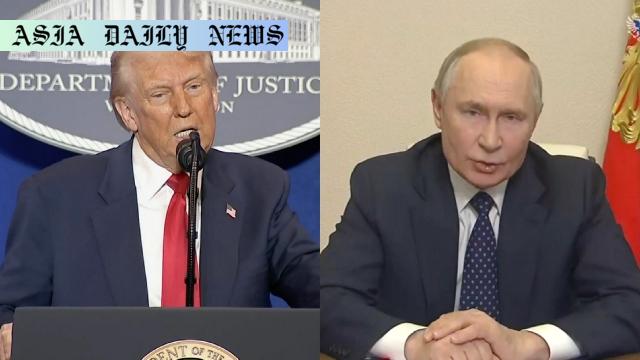Ceasefire: US presidential envoy confirms talks in Saudi Arabia amid ongoing attacks between Russia and Ukraine.
Ceasefire talks between US and Russia are scheduled for Sunday in Saudi Arabia.
Putin agreed to a partial pause on energy attacks, not a full ceasefire.
US, Russia, and Ukraine continue mutual accusations and conflicts.
Drone attacks and missile interceptions escalate tensions across regions.

US and Russia Set to Resume Talks Amid Escalating Conflict
In a significant development, a continuing effort to achieve peace in Ukraine has been set in motion, with the US and Russia scheduled to meet for ceasefire talks this coming Sunday in Saudi Arabia. The announcement came from Steve Witkoff, the US President’s special envoy, who revealed that both US Secretary of State Marco Rubio and National Security Advisor Mike Waltz would be representing the United States. However, details about the Russian counterparts or intermediaries involved remain unclear. This meeting comes against the backdrop of ongoing conflicts and escalating drone warfare between Russia and Ukraine, stressing the critical need for dialogue to mitigate the humanitarian crisis.
Partial Commitments Amid Unyielding Hostilities
One of the more notable developments leading up to these talks was a phone call between Russian President Vladimir Putin and his US counterpart, Donald Trump. During the call, Putin reportedly agreed to pause attacks on energy facilities for 30 days, potentially alleviating the dire situation faced by Ukraine’s civilian population. However, the Kremlin has made it clear that this does not equate to a complete ceasefire agreement. Meanwhile, Ukraine’s air defense continues to grapple with incoming attacks, reporting the interception of six Russian missiles and 145 drones. On the other hand, Russia has claimed the downing of 57 Ukrainian drones within a similar timeframe.
Drone Attacks: A New Dimension in Warfare
The increasing use of drones by both Russian and Ukrainian forces has added an alarming dimension to the ongoing conflict. Authorities in Russia’s Krasnodar region reported that falling drone debris had ignited a fire at an oil depot, exemplifying the spillover effects of this confrontation. Conversely, Ukraine continues to bolster its air defenses with significant success, even as it remains under sustained assault. Both countries have leveraged drones as an effective and cost-efficient means of extending their reach, but the resulting damage to infrastructure and the environment has further exacerbated the humanitarian and ecological toll of the war.
Fragile Hope Amid Growing Concerns
As talks open on Sunday, the international community watches closely, hoping that the US-led efforts will yield substantial progress. The potential for even a temporary cessation of violence could provide some relief to the many civilians currently caught in the crossfire. Regional powers, such as Saudi Arabia, hosting the negotiations, are also gaining prominence as key mediators in what remains an incredibly complex diplomatic endeavor. However, with neither side willing to back down fully, the path towards a long-term resolution remains fraught with challenges. Experts suggest that while agreements may be made in parts, achieving lasting peace will demand considerable compromise and trust-building from all parties involved.
Global Implications of the Ongoing Conflict
The implications of the Russia-Ukraine conflict extend far beyond the immediate region. European energy markets have been particularly impacted, with Russia’s focus on energy facilities threatening supplies across multiple countries. Additionally, the use of drones and missile warfare has introduced innovative military strategies with potentially far-reaching consequences for global security. While Sunday’s talks represent a glimmer of hope, they are just one step in a long and arduous journey towards resolving a conflict that has deeply polarized international relations and triggered a humanitarian crisis.
Commentary
Optimism Amid Complexity
The upcoming ceasefire talks between the US and Russia offer a glimmer of hope for resolving one of the most contentious conflicts in recent history. These discussions, taking place in Saudi Arabia, signify a willingness by both powers to explore diplomatic avenues. However, as history shows, success in such negotiations is never easy. Both sides stand firm on their positions, and the inclusion of intermediaries, while promising, may not guarantee a fruitful outcome.
Challenges on the Road to Peace
Despite President Putin’s agreement to halt energy attacks for 30 days, it is evident that there remains a significant gap in expectations among the involved parties. A temporary pause is a step in the right direction, but it merely scratches the surface of what’s required to stabilize the region. Drone warfare, too, adds a complicating factor, prolonging the cycle of attack and retaliation. Both Russia and Ukraine appear to be locked in a deadly technological race, showcasing the evolution of modern warfare but failing to consider its devastating effects.
The Role of Neutral Facilitators
Saudi Arabia’s role as the host of these talks further highlights how regional actors are emerging as critical stakeholders in global crises. The kingdom’s influence and neutrality can lend credibility to these discussions, although their success ultimately depends on the participating parties’ willingness to compromise. With ongoing global attention on this conflict, even the smallest positive outcomes could pave the way for continued efforts toward a resolution.


